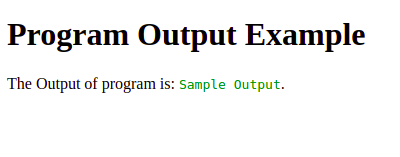When to use <samp> tag in HTML ?
Last Updated :
04 Mar, 2024
The <samp> tag in HTML is used to define sample output from a computer program. It is typically used to represent text that is the output of a program or script. The <samp> tag is an inline tag and its content is rendered on the browsers in a monospaced font.
Syntax:
<samp> Sample output text </samp>
Example: The basic example of <samp> tag.
HTML
<!DOCTYPE html>
<html lang="en">
<head>
<meta charset="UTF-8">
<meta name="viewport" content=
"width=device-width, initial-scale=1.0">
<title>Sample Output Example</title>
</head>
<body>
<h1>Program Output Example</h1>
<p>
The Output of program is:
<samp>Sample Output</samp>.
</p>
</body>
</html>
|
Output:

Example 2: in this example, we will show an error by using <samp> tag.
HTML
<!DOCTYPE html>
<html lang="en">
<head>
<meta charset="UTF-8">
<meta name="viewport" content=
"width=device-width, initial-scale=1.0">
<title>Sample Output Example</title>
<style>
samp {
color: green;
}
</style>
</head>
<body>
<h1>Program Output Example</h1>
<p>
The Output of program is:
<samp>Sample Output</samp>.
</p>
</body>
</html>
|
Output:

Like Article
Suggest improvement
Share your thoughts in the comments
Please Login to comment...